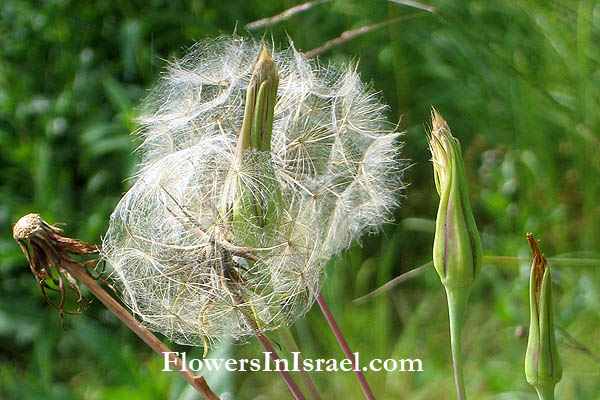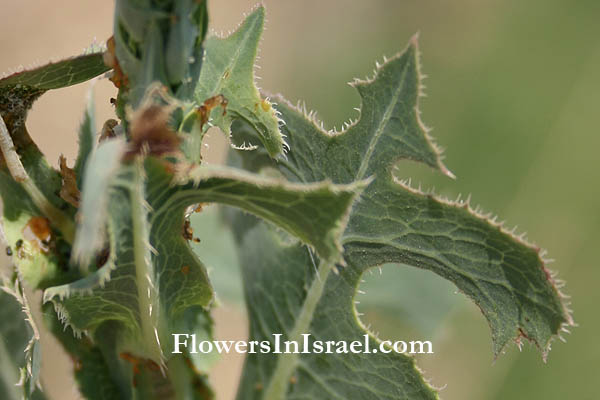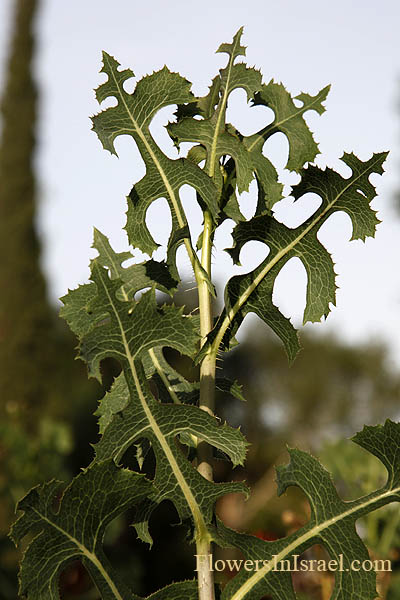Scarole, Broom lettuce, Wild lettuce,
Hebrew: חסת המצפן, Arabic: خَسّ الزَّيْت, Egypt: خس إلبقر "Khas El-Baqar"
| Scientific name: | Lactuca serriola L. | |
| Synonym name: | Lactuca scariola L. | |
| Common name: | Prickly lettuce, Scarole, Broom lettuce, Wild lettuce | |
| Hebrew name: | חסת המצפן | |
| Arabic name: | خَسّ الزَّيْت | |
| Egypt: | خس إلبقر "Khas El-Baqar" | |
| Nederlandse naam: | Kompassla | |
| Family: | Compositae / Asteraceae, מורכבים |

|
| Life form: | Therophyte, annual | |
| Stems: | 30-190 cm high; erect, stout, round, reddish green, glabrous, containing a milky latex | |
| Leaves: | Alternate, rosette, entire, dissected, dentate or serrate | |
| Inflorescence: | Open panicle 15–90 cm long by 10–70 cm wide of numerous flower heads | |
| Flowers: | Flower head 8-14 mm wide, cream, yellow toothed petals; involucral bracts, in 3 or 4 series, overlapping edges, green with reddish tips; disc florets absent; ligulate florets perfect, | |
| Fruits / pods: | Achenes grey, bristly tipped; pappus white with equal lengthed hairs | |
| Flowering Period: | July, August, September, October | |
| Habitat: | Disturbed habitats, Nutrient-rich soils, ruderal | |
| Distribution: | Mediterranean Woodlands and Shrublands, Semi-steppe shrublands, Shrub-steppes, Deserts and extreme deserts, Montane vegetation of Mt. Hermon | |
| Chorotype: | Euro-Siberian - Med - Irano-Turanian | |
| Summer shedding: | Ephemeral |

Derivation of the botanical name: Lactuca, Latin lact, milk, referring to the milky sap. serriola, pertaining to salad, being one form of an old name for chicory. scariola, an Italian name for Succory (Nicholas Culpeper). The Hebrew name: חסה, hasa (New Hebrew), lettuce; from Aramaic: חסא, which is of uncertain origin.
The history of Lactuca (lettuce) can be traced way back to the ancient Egyptians. Lactuca was closely associated with Min, the Egyptian god of fertility, and also featured in the aftermath of the homosxual assault of Seth on Horus. Thus the lettuce aquired the reputation of being aphrodisiac. Min is often depicted holding a rosette of Lactuca Serriola. Lactuca was also used by the Romans and Augustus was said to have raised a statue in honor of the Lettuce infusion that he claimed saved his life. Pliny the Elder (23 - 79 AD), wrote extensively of Lactuca in his work Naturalis Historia. Dioscorides (circa 40—90 AD) says that "it is similar in virtue to the Poppy," since it is suporific and painkilling. Lactucarium was produced by pharmaceutical companies until about the 1940's. 
Location: Kibbutz Ma'agan, Sea of Galilee |